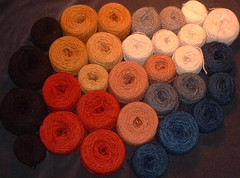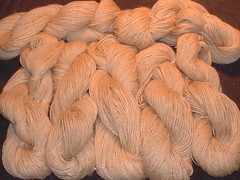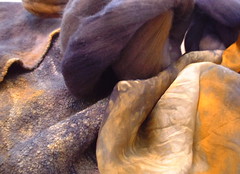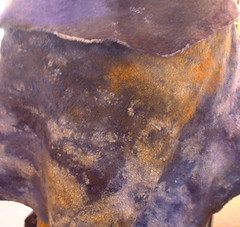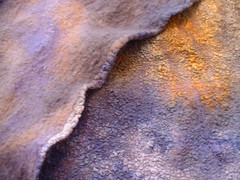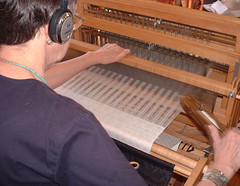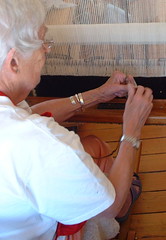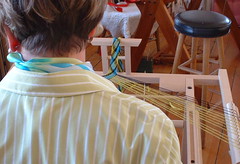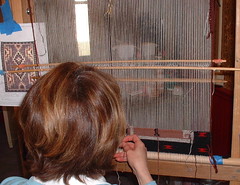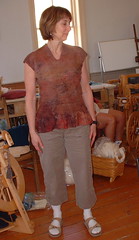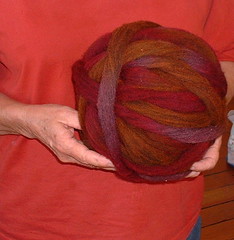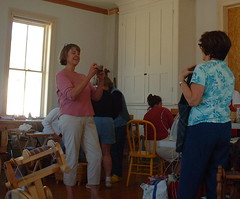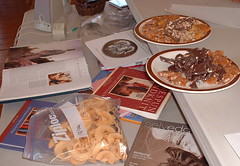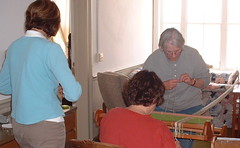Baby Steps
Thanks for all of your kind words of encouragement for the new, big, fear-inducing project I am facing. It helps to know I am not alone, and I also try to tell myself it is just weaving. Earth will not tip on its axis if it's not perfect. Moving on:
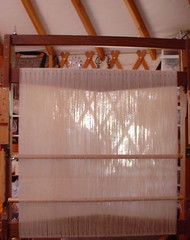
Luckily, weaving is a step-by-step process. As long as I think of just the next step, the big projects are less daunting. I love warping too, which helps, the lining up of all those neat little threads, and the still unsullied potential:
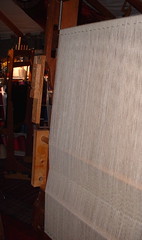
I have little nails marking the warp in 1" increments, and a mantra which helps keep the process going (26 down, 10 to go):
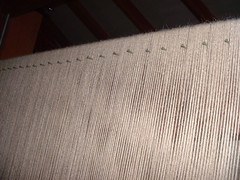
The only casualty so far:
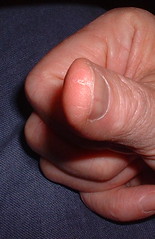
My thumb. The coarse warp yarn wore a groove in the top of my finger (ouch!).
Most projects start out with hopes and expectations. Many projects finish with a satisfied sigh of completion and a job well done. Some projects either languish, unfinished, caught at a point of dilemma, or are finished having not reached the hoped-for outcome. If I am honest, about 1 project in 10 is really spectacular, and about 1 in 10 is a dog which should never have seen the light of day. The rest are fine, good, serviceable, but not breathtaking: towels, curtains, fabric; good cloth, but not masterpieces.
I live for the breathtaking, the occassional project which has more hopes, dreams and energy attached to it. I plan more carefully for these projects and take the baby steps mindfully so there is a possibility of achieving breathtaking again.
Baby steps: first the warp goes on the loom, then I'll tie the heddles, the re-tension so that every warp is taught and even (never really get to even, but I get close), then some twining, the hem and finally, at last, the knotting. I have lots of baby steps before Iruin begin to weave the Big Scary Project.
Weaving is good with the baby steps. Besides warping, sometimes (as now) directly onto the loom, there is threading heddles or in this case making the heddles, devices used to create the shed, or the space between layers of warp where the weft will pass. Tensioning and tieing-on are the last steps before the first, tentative actual weaving begins: the header, or hem.
So weaving, while appearing to be a daunting process overall, is a series of events, not unlike, say, spinning: first we sort, pick through and wash the fleece. Then we pick the locks, and card or comb the fibers, or dye them and then card or comb them, then oil the wheel, pick up the roving and begin. The hope and potential is kept alive through the several steps which precede the actualruining spinning the fibers.
Ahem. Working on the attitude here, really, I am.
Starting at the wrong place in the process makes anything more difficult. My friend Sue is weaving again, having bought a new rigid heddle loom. Sue owned and wove on a Harrisville loom long ago but sold it, moved, and spent several years working and away from thoughts of weaving.
Once retired though, an opportunity arose for her to buy an AVL loom for a good price, with attendant goodies like shuttles, books, swifts and assorted tools. She was lured back into thinking of weaving.
The AVL, though, is not a first loom. It was like jumping into the middle of a project, a bit overwhelming. A couple of guild members who own and use an AVL tried to help, but they are long past the Baby Steps part of the process, and only made the whole thing more confusing. Sometimes it is challenging to break a process down into the increments that allow for understanding.
Sue got frustrated and sold the big loom. She tip-toed into shallow waters once again with a smaller loom, a Baby Wolf, but it languished in the corner while she recovered from an illness. She sold it, thinking she'd never have the energy again to weave.
Then, along came BJ, who weaves on and teaches weaving with a rigid heddle loom. BJ is patient, soft spoken, not demanding nor didactic, a good teacher. She was encouraging, and showed Sue all the nice things she (BJ) had woven on her rigid heddle loom.
So Sue bought one, and BJ helped her set it up. When it came time to set it up again, Lindsey patiently worked through the process with Sue, giving her more confidence and a successful second project. Sue warped and is weaving the third project now by herself, having woken up in the middle of the night with an idea of houndstooth fabric.
Baby steps. It is what brought Sue back to weaving. The right teacher, a calm and non-judgemental person, and a good friend who knew a lot about weaving and could walk Sue through it step by step the second time. And now Sue is off and running, weaving again, on her own:
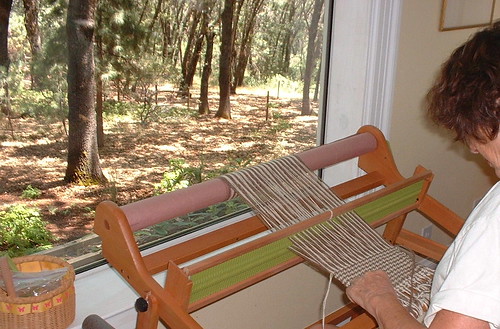
Baby steps.

Luckily, weaving is a step-by-step process. As long as I think of just the next step, the big projects are less daunting. I love warping too, which helps, the lining up of all those neat little threads, and the still unsullied potential:

I have little nails marking the warp in 1" increments, and a mantra which helps keep the process going (26 down, 10 to go):

The only casualty so far:

My thumb. The coarse warp yarn wore a groove in the top of my finger (ouch!).
Most projects start out with hopes and expectations. Many projects finish with a satisfied sigh of completion and a job well done. Some projects either languish, unfinished, caught at a point of dilemma, or are finished having not reached the hoped-for outcome. If I am honest, about 1 project in 10 is really spectacular, and about 1 in 10 is a dog which should never have seen the light of day. The rest are fine, good, serviceable, but not breathtaking: towels, curtains, fabric; good cloth, but not masterpieces.
I live for the breathtaking, the occassional project which has more hopes, dreams and energy attached to it. I plan more carefully for these projects and take the baby steps mindfully so there is a possibility of achieving breathtaking again.
Baby steps: first the warp goes on the loom, then I'll tie the heddles, the re-tension so that every warp is taught and even (never really get to even, but I get close), then some twining, the hem and finally, at last, the knotting. I have lots of baby steps before I
Weaving is good with the baby steps. Besides warping, sometimes (as now) directly onto the loom, there is threading heddles or in this case making the heddles, devices used to create the shed, or the space between layers of warp where the weft will pass. Tensioning and tieing-on are the last steps before the first, tentative actual weaving begins: the header, or hem.
So weaving, while appearing to be a daunting process overall, is a series of events, not unlike, say, spinning: first we sort, pick through and wash the fleece. Then we pick the locks, and card or comb the fibers, or dye them and then card or comb them, then oil the wheel, pick up the roving and begin. The hope and potential is kept alive through the several steps which precede the actual
Ahem. Working on the attitude here, really, I am.
Starting at the wrong place in the process makes anything more difficult. My friend Sue is weaving again, having bought a new rigid heddle loom. Sue owned and wove on a Harrisville loom long ago but sold it, moved, and spent several years working and away from thoughts of weaving.
Once retired though, an opportunity arose for her to buy an AVL loom for a good price, with attendant goodies like shuttles, books, swifts and assorted tools. She was lured back into thinking of weaving.
The AVL, though, is not a first loom. It was like jumping into the middle of a project, a bit overwhelming. A couple of guild members who own and use an AVL tried to help, but they are long past the Baby Steps part of the process, and only made the whole thing more confusing. Sometimes it is challenging to break a process down into the increments that allow for understanding.
Sue got frustrated and sold the big loom. She tip-toed into shallow waters once again with a smaller loom, a Baby Wolf, but it languished in the corner while she recovered from an illness. She sold it, thinking she'd never have the energy again to weave.
Then, along came BJ, who weaves on and teaches weaving with a rigid heddle loom. BJ is patient, soft spoken, not demanding nor didactic, a good teacher. She was encouraging, and showed Sue all the nice things she (BJ) had woven on her rigid heddle loom.
So Sue bought one, and BJ helped her set it up. When it came time to set it up again, Lindsey patiently worked through the process with Sue, giving her more confidence and a successful second project. Sue warped and is weaving the third project now by herself, having woken up in the middle of the night with an idea of houndstooth fabric.
Baby steps. It is what brought Sue back to weaving. The right teacher, a calm and non-judgemental person, and a good friend who knew a lot about weaving and could walk Sue through it step by step the second time. And now Sue is off and running, weaving again, on her own:

Baby steps.
